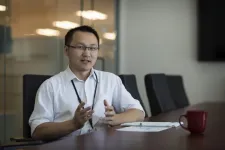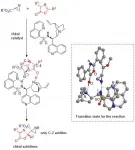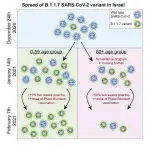(Press-News.org) Eyes play an important role in social communication by expressing the intentions of our interlocutors, and even more so in times of pandemic when half of the face is hidden. But is this eye contact automatic and rapid? Is it based on a priority attentional reaction or, on the contrary, on a particular emotional reaction? To answer these questions, researchers at the University of Geneva (UNIGE), Switzerland, looked at the way we process human gaze, focusing on the estimation of the temporal duration of social interactions. They discovered that when we make eye contact with another person, our attention is directly solicited, causing a distortion in our temporal perception. As a result, time seems shorter than it really is. On the contrary, this underestimation of time does not occur when we look at a non-social object. These results, to be read in the journal Cognition, will make it possible to develop a diagnostic tool to evaluate the mechanisms at work in people who are sensitive to social gaze, and then to act accordingly if disorders in the processing of social stimuli are detected, for instance in the case of autism or schizophrenia.
The way we look at others and the way we perceive others' gaze have a major impact on social communication, a fundamental function called social cognition. "From an early age, we learn to decipher the feelings and intentions of our interlocutors through their eyes. Thus, meeting someone's gaze is a very common social situation, but it always leads to a particular feeling", notes Nicolas Burra, a researcher at the Psychology Section of the Faculty of Psychology and Educational Sciences (FPSE) at the UNIGE, and first author of the study. Two hypotheses are put forward to describe this situation: one says that eye contact with others directly generates an emotional reaction, without passing through our attention. The second hypothesis is that eye contact activates rapid and automatic attentional processing, which subsequently generates an emotional response.
Our perception of time influenced by emotion and attention
To test these hypotheses, the UNIGE researchers looked at the way we perceive time, which varies according to the emotional or attentional processing of the visual stimulus. "Indeed, it has been shown that when our emotional capacities have to process an unpleasant visual stimulus, for example if we are asked to evaluate the time of the appearance of a large spider, we will overestimate the time that passes, giving the impression that it is flowing more quickly than it actually does", explains Nicolas Burra. Thus, our ability to evaluate time is disturbed by the emotional charge and accelerates. On the contrary, when the visual stimulus is processed by attention, the opposite effect occurs: focused on a stimulus that is very important for our attention, we underestimate the time that elapses and look at the object longer than we imagined. "By analyzing how long a person estimates that he or she has been looking at an object, we can determine whether the eye contact between two people is more attention-seeking or emotion-seeking", says the Geneva-based researcher.
Deviated gazes versus eye contact
To assess the impact of eye contact on our perception of time, 22 participants observed a series of nearly 300 faces moving their eyes: either gazes establishing direct eye contact - eyes look into the void and then catch the participant's gaze - or deviated gazes - the same eye movement is made, but the face and the participant's gaze never meet. Over a period of 20 minutes, the participants subjectively assessed the different durations (between 1 and 2 seconds, close to everyday social interactions) of these social interactions. "While deviated glances do not distort our perception of time, we found that, on the contrary, when glances crossed, the participants systematically underestimated the duration of these eye contacts", says Nicolas Burra. This experiment reveals that eye contact does not primarily impact the emotional system, but rather the attentional system that distracts us from our ability to evaluate time.
To assess these results, the UNIGE researchers carried out the same experiment with other participants, using non-social objects that made the same movements as the gaze. In that case, no distortion of time perception was observed. The same was true when a face was static. "It seems that not only a gaze, but also a movement is required", the neuroscientist points out. The time-distortion effect was found, however, when the participants were shown only schematic eye movements or moving parts of the eyes without the rest of the face - a situation that is similar to social interaction with a mask. But it goes further, because this effect was also found in an online experiment with a hundred people, corroborating and generalizing the results obtained in the laboratory.
Eye contact captures attention
This series of experiments shows that eye contact and social stimuli impacts attention, preferentially. "This explains the sensation we feel when someone looks at us even though we have not yet really met their gaze", explains Nicolas Burra. This work will make it possible to evaluate and then intervene more precisely on the attentional or emotional processes in people suffering from disorders in the processing of social stimuli, characterized by a lack of interest, a misinterpretation of the gaze or by an extreme emotional reaction to others' gaze, such as in autistic people, schizophrenics or people suffering from social anxiety. The research team is currently carrying out this experiment with children and elderly people, in order to observe the evolution of this preferential processing of eye contact by attention over the lifespan. Nicolas Burra concludes: "This study gives meaning to the sensation that time stops when we meet another's gaze."
INFORMATION:
A biomimicking "spiking" neural network on a microchip has enabled KAUST researchers to lay the foundation for developing more efficient hardware-based artificial intelligence computing systems.
Artificial intelligence technology is developing rapidly, with an explosion of new applications across advanced automation, data mining and interpretation, healthcare and marketing, to name a few. Such systems are based on a mathematical artificial neural network (ANN) composed of layers of decision-making nodes. Labeled data is first fed into the system to "train" the model to respond a certain way, then ...
LA JOLLA, CALIF. - April 20, 2021 Scientists at Sanford Burnham Prebys have identified, at an atomic level, how a part of a protein called PLEKHA7 interacts with a cell's membrane to regulate important intercellular communications. The research, published in the journal Structure, points to hotspots within PLEKHA7 as targets for drugs. These targets could be key in designing treatments for advanced colon, breast and ovarian cancers.
The region, or domain, in PLEKHA7 that the researchers examined, pleckstrin homology (PH), is commonly found in proteins ...
A long-awaited, high-tech analysis of the upper body of famed fossil "Little Foot" opens a window to a pivotal period when human ancestors diverged from apes, new USC research shows.
Little Foot's shoulder assembly proved key to interpreting an early branch of the human evolutionary tree. Scientists at the END ...
Recent growth in the number of healthcare workers providing home care for Medicare patients is "small and inadequate" compared with the increasing demand in an aging America, a new study suggests.
To have hope of keeping up, Medicare likely will need to reconsider how it compensates providers for home care, the researchers say.
"Only 0.7 percent of physicians in Medicare provided home care regularly," said Nengliang "Aaron" Yao, PhD, a researcher with the University of Virginia School of Medicine's Section of Geriatric Medicine. "Targeted policies are needed to support home-based medical care."
Trends in Home Care
Growth in the field of home care was "modest but steady" between 2012 and 2016, with most of the growth coming from increasing numbers of nurse practitioners providing home ...
A novel system of chilled panels that can replace air conditioning can also help reduce the risk of indoor disease transmission, suggests new analysis from the University of British Columbia, University of Pennsylvania and Princeton University.
The researchers computed air conditioning requirements in 60 of the world's most populous cities--with the additional ventilation required due to COVID-19. Then, they compared the energy costs with their cooling method, using the chilled panels and natural ventilation.
The results, published in the COVID-19 edition of Applied Energy, showed that the alternative solution can save up to 45 per cent of the required energy, while ensuring building occupants are comfortable ...
Nearly three-quarters of Earth's land had been transformed by humans by 10,000BC, but new research shows it largely wasn't at the expense of the natural world.
A study involving University of Queensland researchers combined global maps of population and land use over the past 12,000 years with current biodiversity data, demonstrating the effective environmental stewardship of Indigenous and traditional peoples.
UQ's Professor James Watson said the findings challenged the modern assumption that human 'development' inevitably led to environmental destruction.
"There's a paradigm among natural scientists, conservationists and policymakers that ...
Unless you've studied chemistry in college, it's unlikely you've come across the name aziridine. An organic compound with the molecular formula, C2H4NH, aziridines are well-known among medicinal chemists, who make use of the compound to prepare pharmaceutical drugs such as Mitomycin C, a chemotherapeutic agent known for its anti-tumor activity. Specifically, aziridines are what chemists call "enantiomers"--molecules that are mirror images of each other and cannot be superposed on one another. A peculiarity with enantiomers is that the biological activity ...
A team headed by Dr. Phillip M. Maffettone (currently at National Synchrotron Light Source II in Upton, USA) and Professor Andrew Cooper from the Department of Chemistry and Materials Innovation Factory at the University of Liverpool joined forces with the Bochum-based group headed by Lars Banko and Professor Alfred Ludwig from the Chair of Materials Discovery and Interfaces and Yury Lysogorskiy from the Interdisciplinary Centre for Advanced Materials Simulation. The international team published their report in the journal Nature Computational Science from 19 April 2021.
Previously manual, time-consuming, error-prone
Efficient analysis of X-ray diffraction data (XRD) plays a crucial role in the discovery of new materials, for example for the energy ...
A new study at Tel Aviv University found that the British variant (termed: B.1.1.7) of Covid-19 is 45% more contagious than the original virus. The researchers relied on data from about 300,000 PCR tests for Covid-19 obtained from the COVID-19 testing lab, which was established in collaboration with the Electra Group.
The new study was conducted by Prof. Ariel Munitz and Prof. Moti Gerlitz of the Department of Clinical Microbiology and Immunology at the Sackler Faculty of Medicine, together with Dr. Dan Yamin and PhD student Matan Yechezkel from the Laboratory for Epidemic Modeling and Analysis (LEMA) at the Department of Industrial Engineering, all at Tel Aviv University. The study's results were published in the prominent scientific ...
Musty, moldy, smoky or horse dung-like smelling cocoa is not suitable for chocolate production. As part of a larger research project, a team of scientists led by Martin Steinhaus from the Leibniz Institute for Food Systems Biology at the Technical University of Munich has identified the odorants responsible for such off-flavors. The food industry can now use these results to objectively assess the sensory quality of fermented cocoa based on odorant concentrations. The research team published the data in the Journal of Agricultural and Food Chemistry.
Who likes chocolate ...







